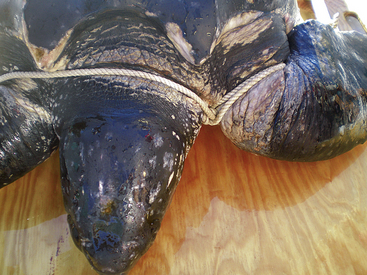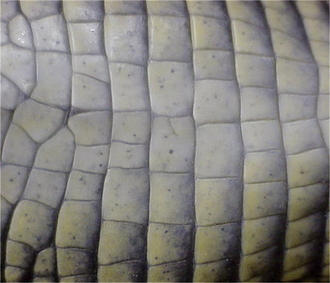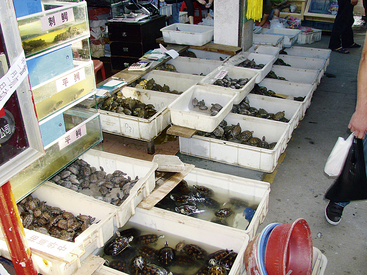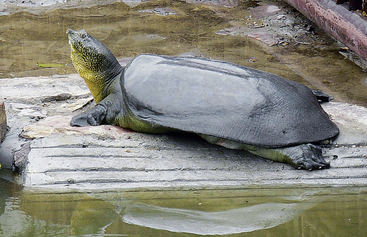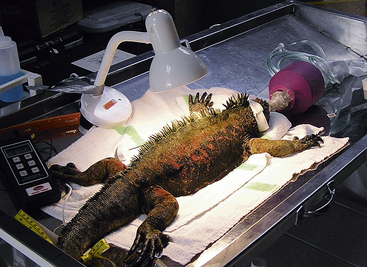Chapter 27
Conservation Issues
Veterinary Contributions to Reptile Conservation
Veterinarians play an important role in biodiversity conservation.1 Veterinarians with expertise in the medical management of reptiles have participated in a variety of reptile conservation programs for several decades, and involvement in such programs has increased substantially in the first decade of the twenty-first century. Well-known conservation and recovery programs for species such as Galapagos Tortoises (Chelonoidis [Geochelone] nigra), Chinese Alligators (Alligator sinensis), and Kemp’s Ridley Sea Turtle (Lepidochelys kempii) have utilized veterinarians in developing quarantine programs, disease management, pathology investigations, nutritional planning, and more (Figures 27-1 and 27-2).2–7
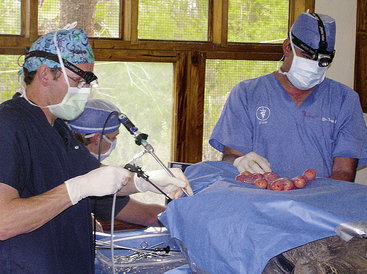
FIGURE 27-1 Drs. Stephen Divers and Sam Rivera performing endoscope-assisted oophroectomy in a Galapagos Tortoise (Chelonoidis [Geochelone] nigra) in the Galapagos Islands. This project sterilized genetically hybridized tortoises so that they could be released onto the islands to function as ecologically important large herbivores until genetically pure tortoises can be reestablished. (Photo courtesy Dr. Joe Flanagan, Houston Zoo, Houston, Tex.)
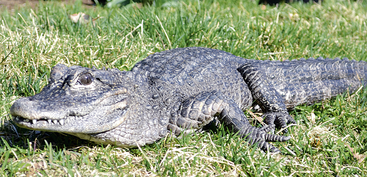
FIGURE 27-2 This Chinese Alligator (Alligator sinensis) was hatched as part of a captive breeding program for this rare species. (Photo courtesy Michael Ralbovsky, Rainforest Reptile Shows, Mass.)
The number of endangered reptile species is increasing, largely because of habitat loss and unsustainable harvesting or incidental mortality associated with human activities.8–10 In addition, it is likely that for some taxa, climate change, pollution, competition with invasive species, and disease, may also be detrimental.8 In 2011, the International Union for the Conservation of Nature (IUCN) Red List of Threatened Species categorized 32 turtle species, 6 crocodilian species, and 83 squamate species as critically endangered and 44 turtle species, 1 crocodilian species, and 189 squamate species as endangered.11 These categories respectively indicate an “extremely high” or “very high” risk of extinction in the wild. Of great concern is the continued decline of many populations despite significant conservation efforts over the past decade.12 Regardless of numerous conservation activities, threats to many reptile populations remain extremely serious.
Basic Ecology Studies
Implementing effective conservation strategies for any species requires a thorough understanding of its natural history. Data such as population size, home range, fecundity, recruitment, sex ratios, longevity, migratory patterns, and genetic diversity are required. While historically the realm of herpetologists, ecologists, and general biologists, field studies increasingly involve or require veterinary expertise or oversight. Veterinarians have particularly become involved with the surgical implantation or attachment of telemetry devices, passive integrated transponder (PIT or microchip) tagging, laparoscopic reproductive evaluation, oversight of capture events, administration of anesthesia in the field, and assessment of the safety of techniques used by field biologists. Surgical implantation or attachment of radio or satellite transmitters has become a routine part of many reptile ecology studies (Figure 27-3).13,14 Such transmitters can be used to track the location of the animal over time, and more advanced transmitters can also record temperature or dive depth data. While PIT tags have been used by reptile biologists for some time, recent veterinary observations have led to modification of tag implantation techniques and have highlighted complications seen with PIT tag insertion in certain species and in certain anatomic locations.15,16 See Chapter 29 for more details.
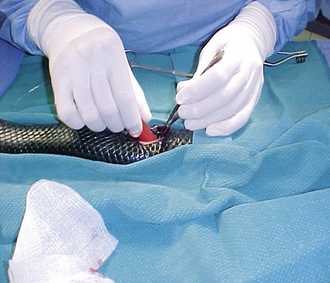
FIGURE 27-3 Radio transmitter implantation into the coelom of an Indigo Snake (Drymarchon couperi) in Georgia, United States. (Photo courtesy Dr. Terry M. Norton, Georgia Sea Turtle Center, Jekyll Island, Ga.)
Laparoscopy and, recently, cystoscopy have been used to determine the sex of immature reptiles so that sex ratios produced under natural or artificial conditions could be assessed (see Chapter 13, Diagnostic Endoscopy. 17–19 This information is especially important for programs that artificially incubate eggs of species that exhibit temperature-dependent sex determination or artificially enhance the survival likelihood of juveniles (“head starting”). Nonlethal early identification of sex may be important for monitoring the potential effects of global climate change on species for which sex determination is temperature dependent. Laparoscopy has also been used, particularly in sea turtles, for assessment of the reproductive status of subadults and adults as part of population-based reproductive health studies.20
Veterinary involvement in field procedures has resulted in the development of safe short-acting anesthetic protocols and has highlighted possible adverse effects of some types of manual restraint.4,5,21–23 For example, potentially adverse positional effects on intraocular pressures were documented by veterinarians during a Loggerhead Sea Turtle (Caretta caretta) laparoscopy study.23 Blood collection is often required for basic ecology studies, and veterinarians have recently developed position statements on acceptable and unacceptable methods for blood collection from tortoises in the field.24
Federal authorities may require a veterinarian to be involved with certain procedures for protected species. For example, in the United States, studies that involve capture and handling of the endangered Leatherback Sea Turtle (Dermochelys coriacea) require the presence of a veterinarian for physiological monitoring and emergency resuscitation if adverse events occur (Figure 27-4).14,25
Health Evaluation of Reptile Populations
The number of “health assessment” or “health evaluation” studies of “normal” populations of free-ranging reptiles is increasing. It can be debated how to define normal, and many reptile populations have already been infiltrated by disease, toxins, and other stressors. Clinical pathologists debate whether these studies are producing baseline data, normal values, reference intervals, or other values. In many cases, the number of animals involved in the study is less than desired for determination of true reference intervals. Nonetheless, these studies seek to characterize various aspects of the health of native reptiles in their natural habitats, often focusing on hematology, plasma biochemistry, fecal parasitology, and serologic evidence of disease exposure. In many cases, these studies provide the only available data for a given species; thus they can be valuable for comparison to clinical data obtained from captive reptiles and for comparison to future data from the same population.26–31 Health evaluations have highlighted the significant effects of seasonality, sex, age, and stressors on clinical pathology data of reptiles.14,25,31–33 If free-ranging reptiles are broadly screened, specific abnormalities may be found, which may lead the way to more specific studies.
Infectious Disease Research
The population decline of North American tortoises of the genus Gopherus has been well-documented and is likely due in part to an upper respiratory tract disease caused by Mycoplasma agassizii.34 The identification and characterization of this disease was largely due to the efforts of veterinary professionals and their colleagues.34 Similarly, much of the characterization of the fibropapilloma syndrome of sea turtles was completed by veterinarians.33,35 The threat of disease for many reptile populations is unclear, but it is likely that catastrophic population declines could occur due to the introduction of infectious diseases. As such, characterization of infectious diseases of reptiles is critical for reptile conservation, even if only characterized in captive reptiles. Familiarity with etiologic agents, clinical signs, pathologic lesions, pathogenesis, and diagnostic modalities may expedite the future identification of known pathogens in free-ranging populations and may allow for more rapid characterization of novel pathogens.
In recent years, characterization of iridovirus, adenovirus, herpesvirus, and novel protozoal infections in captive and free-ranging chelonians has provided a great deal of basic data that will be useful for future disease investigations.36–45 Documentation of West Nile Virus infection in alligators in the United States demonstrated infection of a novel host with an exotic virus (Figure 27-5).46–48 Such outbreaks should convince those involved with reptile conservation programs that the risk of infectious disease is real, especially for programs involving translocation and repatriation. Animals involved in such programs should be carefully screened for disease by following recommended veterinary protocols.28,49,50
Asian Turtle Crisis
The magnitude of the live turtle trade in Southeast Asia has been widely reported over the past decade.9 Beginning in the late 1990s, a number of conservation organizations and private individuals began to document the unsustainable consumption of Asian turtles for food and medicinal use. Networks of turtle collectors began to harvest species broadly across Southeast Asia and channel them into large markets in cities such as Hong Kong (Figure 27-6). Among the literally tons of turtles in the trade were a variety of critically endangered species and species previously unknown to science. In some cases, novel species were described from specimens found in food markets, having never been observed in the wild.51 As species that rely on the longevity of reproductively mature individuals to ensure population survival, turtles are particularly prone to extirpation due to mortality of adults.52 It became clear that many Asian species were in imminent risk of extinction. In response to this crisis, a number of workshops were held throughout the world, and several alliances and consortiums were created. Since that time, veterinarians have continued to participate in Asian turtle conservation efforts focused on range country programs, ex situ captive breeding, rehabilitation of confiscated specimens, disease description, and education.
Initially, much effort was focused on medical management and rehabilitation of confiscated Asian turtles, for purposes of establishing ex situ “assurance colonies”. Many species’ husbandry needs were poorly known, and most individuals were seriously ill at the time of confiscation. Attempts to maintain these specimens in captivity often failed because the turtles refused food and succumbed to parasitic and bacterial diseases.53–56 Soon, however, medical management protocols began to improve the survival rate of these specimens.53–56 Combined with natural history field studies, this work led to successful treatment, establishment of founder captive populations, and eventual successful breeding of species with historically high mortality rates, such as the Impressed Tortoise (Manouria impressa) and the Sulawesi Forest Turtle (Leucocephalon yuwonoi) (Figure 27-7).57–59 Veterinary work with these species also led to descriptions of a number of novel parasites (e.g., Myxidium hardella), viral diseases (e.g., Sulawesi tortoise adenovirus-1), and common pathologic findings.55,56,60,61
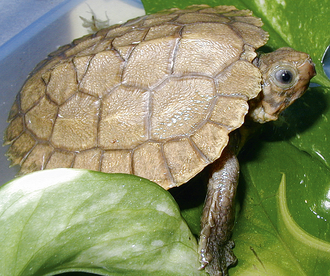
FIGURE 27-7 The first known captive-bred hatchling of the Sulawesi Forest Turtle (Leucocephalon yuwonoi). This hatchling is the offspring of adults salvaged from the Southeast Asian live turtle trade. (Photo courtesy Dr. Charles Innis, New England Aquarium, Boston, Mass.)
Veterinarians have also helped to establish and implement range country conservation and veterinary education programs in Southeast Asia. These efforts have included provision of clinical care, implementation of quarantine programs, and education of local veterinarians at centers such as Cuc Phuong in Vietnam and Madras Crocodile Bank in India.62,63 Recently, veterinarians played a critical role in the transport of one of the last living Yangtze Giant Softshell Turtles (Rafetus swinhoei) into a captive breeding program in China, and veterinarians continue to be involved in the nutritional, medical, and reproductive management of the last individuals of this species (Figure 27-8).64,65 Despite these efforts, the outlook for the majority of Asian turtle species is grim. Recent reassessments of these species by the IUCN demonstrate a 90% increase in the number of species listed as Critically Endangered over the past decade.12
Reptiles Affected By Oil Spills
In the last 10 years, veterinarians have been involved in medical management of reptiles affected by several major oil spills. In 2001, a large oil spill in the Galapagos Islands led to the death of 62% of Marine Iguanas (Amblyrhynchus cristatus) on one affected island, and veterinarians subsequently became involved with the health assessment of this species (Figure 27-9).66,67 In 2010, approximately 800,000 gallons of oil were spilled into the Kalamazoo River in Michigan, and approximately 2000 reptiles and amphibians were admitted into rehabilitation.68 Also in 2010, the massive Deepwater Horizon oil spill in the Gulf of Mexico resulted in contamination of hundreds of endangered sea turtles, including Kemp’s Ridley, Loggerhead, Green (Chelonia mydas), and Hawksbill (Eretmochelys imbricata) Sea Turtles (Figure 27-10).69 Although the majority of turtles that were admitted to rehabilitation survived, the number of turtles that died entrapped in oil at sea remains unknown. The most current publicly available data from the Deepwater Horizon oil spill indicate that approximately 90% of turtles that were admitted to rehabilitation were later released.69 Clinical data obtained by veterinarians during treatment of these oiled turtles are being withheld until legal aspects of the case have been resolved.
Stay updated, free articles. Join our Telegram channel

Full access? Get Clinical Tree


